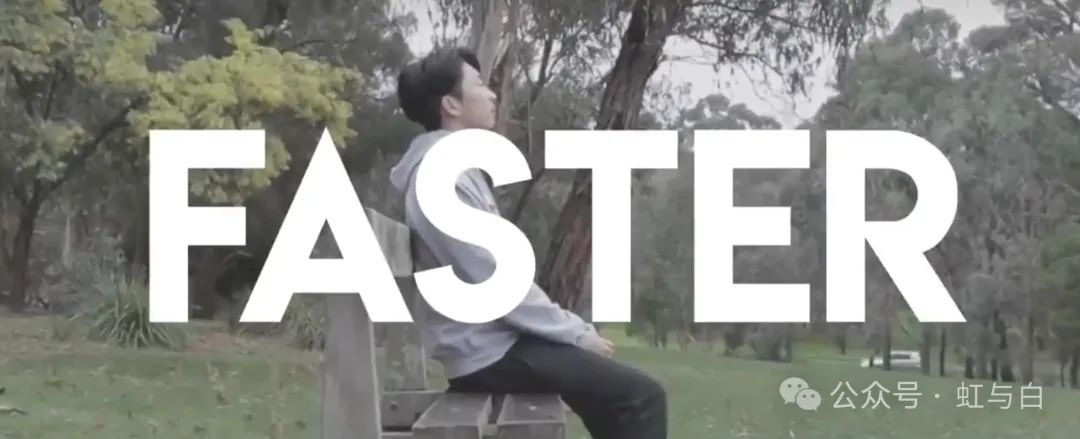
学习速度提升10倍的秘诀(根据斯坦福脑科学家)[1]
介绍
讲述了斯坦福神经科学家Andrew Huberman的学习方法,主要包括“间隙效应”以及其他技巧。间隙效应即在每小时学习中适时暂停30次,帮助大脑更专注和积极吸收知识。
其他方法包括深呼吸保持清醒,选择一个点盯着看提高专注力,以及学习结束后进行深度休息。视频作者发现,这些方法对物理技能的学习非常有效,而对理论知识的学习效果则需要进一步测试和观察。
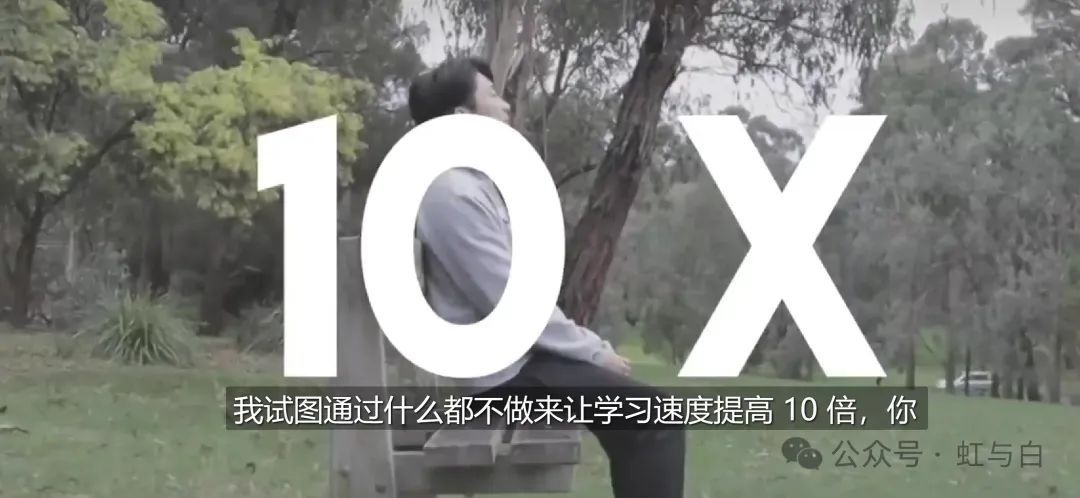
重点内容
重点笔记
学习方法的关键在于“间隙效应”,即在学习过程中适时地暂停放空思绪。
高效学习的步骤包括提高警觉性、提高专注力、合理安排学习和休息时间。
通过深呼吸、盯着一个点看、学习后进行深度休息(如冥想或小憩)等方法可以提高学习效率。
物理技能和脑力技能的学习方法可能有所不同,需要进行个别化的尝试和调整。

践行步骤
① 科学家 Andrew Huberman:
每小时进行大约30次的间隙,即暂停并放空思绪;
通过深呼吸提高警觉性;
选择一个点专注地盯着看30到60秒,以提高专注力;
每次的学习时间不超过90分钟;
学习结束后进行深度休息的活动,如冥想或小憩。

② 视频作者:
在自然地放慢学习速度后进行10秒钟的休息;
通过盯着一个点看以提高专注力;
在学习中途进行10秒钟的休息,以重置注意力;
对于物理技能的学习,作者发现间隙效应非常有效;
对于脑力技能的学习,作者计划进一步测试和观察。
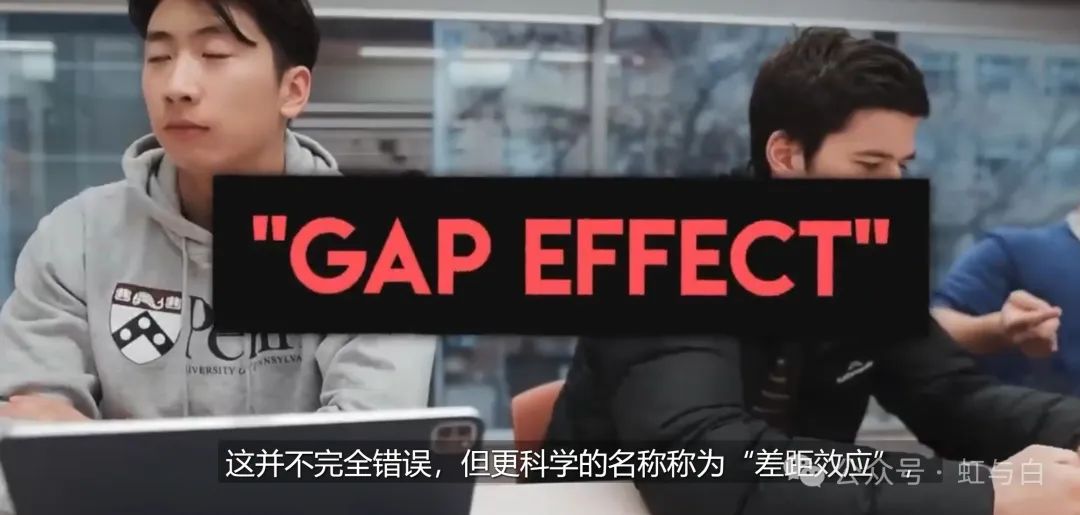
小结
尽管Huberman的学习系统给出了一些具体的步骤和方法,但每个人都是独特的,我们的学习风格和习惯也各不相同。因此,重要的是你能找出适合自己的方法。
例如,你可能发现深呼吸对提高警觉性并没有太大的帮助,但散步或做一些运动能让你更加清醒。或者,你可能发现你需要更长或更短的间隙时间来重置你的专注力。
总的来说,关键在于尝试这些方法,看看哪些对你来说最有效,并根据你自己的需要进行调整。
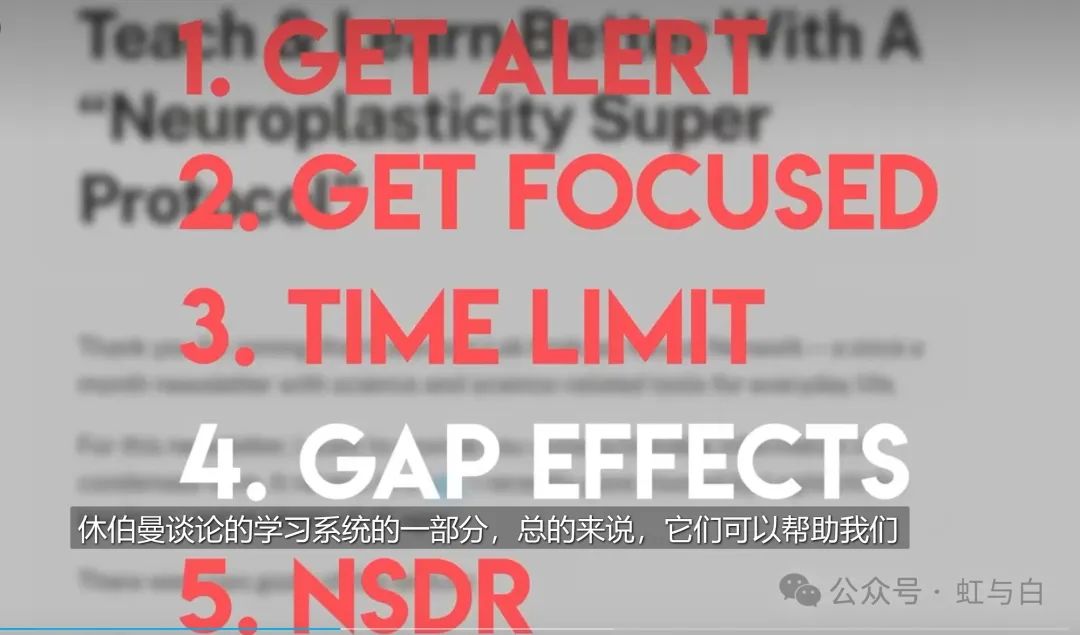
中英全文
1 Here is me, trying to learn 10 times faster by doing nothing. You see, I'm currently following an approach that I've learned from the internet's go-to expert for real productivity advice, who is none other than Stanford neuroscientist, Andrew Huberman.
Andrew Huberman's learning tips have made people say, "Why has that not been incorporated into our educational system?" Speaking of the education system, currently, I'm in the final year of my undergrad, and it's definitely being a challenge to balance all the content with everything else in life.
So, that's why I want to test out this popular and scientifically grounded system that Andrew Huberman talks about for learning faster. At the end, I'll let you know which parts I found the most useful.
我正在尝试通过“什么都不做”来提高学习速度。现在,我正在跟随斯坦福神经科学家Andrew Huberman的方法,他是互联网上真正的生产力建议专家。
Andrew Huberman的学习技巧让人们感叹,"为什么这个方法还没有被纳入我们的教育系统中?”我目前在大学最后一年,平衡所有的课程内容和生活中的其他事情确实是个挑战。
所以,我想要测试Andrew Huberman谈论的这个受科学支持且广受欢迎的快速学习系统。最后,我会告诉你们我觉得哪些部分最有用。
2 "Okay, so if someone gave you the option of learning 10 times faster, you probably wouldn't mind. Well, the way that Hubman says we can actually achieve this is through a very sophisticated process called 'doing nothing'. Okay, so that's not entirely wrong but the more scientific name is called 'The Gap effect'. Here's it explained by the man himself: 'Anytime you're learning something, it pays to have random intervals in which you stop and do nothing.'
Okay, so I've been trying this out recently and Hubman gives the rough number of doing around 30 of these for every hour. But I felt like if I had to consciously count how many of these breaks I do, then that would end up being more distracting than it would be useful.
And at the same time, I didn't want to use any of those apps that do this for you. I think there's some out there, but that seems like it's more complicated than it needs to be.
So, what I ended up doing was, I would just keep working, working, working until I naturally slowed down, and then I'll just take one of these 10-second breaks.
And the thing is, for me and most likely you as well, is that these 10-second breaks is something we probably do unconsciously anyways."
如果有人告诉你有学习速度提升10倍的方法,你应该不会反对吧。Hubman教授的方法就是,通过一个被称为“什么都不做”的复杂过程来实现这一点。这并非完全没有道理,更科学的名字叫做“间隙效应”。Hubman教授自己解释道:“在学习任何东西的时候,有规律地停下来,什么也不做,会很有帮助。”
我最近在尝试这个方法,Hubman教授建议每小时大致做30次这样的间隔。但我觉得如果我必须有意识地计算这些休息的次数,那反而会更加分散我的注意力,反而起不到应有的效果。
同时,我也不想使用那些可以帮你做这件事的应用。我认为这似乎比需要的复杂得多。
所以,我最后做的是,我会一直工作,一直工作,一直工作,直到我自然地放慢速度,然后我会做一次10秒钟的休息。
事实上,对我来说,也很可能对你来说,这些10秒钟的休息可能是我们在无意识中已经在做的事情。
3 So, it's not like we need to put in all this extra effort to force ourselves to take these little breaks. Now you know that staring out the window isn't always a bad thing. Now, I don't want to oversimplify things. These "Gap effects" are just one part of the Learning System that Huberman talks about and, all together, they can help us learn much quicker.
So, the first step in this approach is to get alert. There's lots of ways of doing this, but one way Huberman recommends is taking around 25 deep breaths. Okay, on a serious note, I've been trying this out for some time now and I honestly think that the effects aren't that noticeable for me. Because if I'm tired, I'll just usually go for a walk or do some exercise, because I feel like that's the best way for me, at least, to become alert and actually focus on what I'm doing.
But, I can see how this can be helpful if it's really late and you can't go out and exercise. So, I guess it really depends on your own body clock and your own routine. The next step is to get focused. Now, if you're anything like me, you probably know that focusing is a good thing. It will help us learn much quicker.
我们其实并不需要付出额外的努力去强迫自己做这些小小的休息。现在你知道了,望着窗外发呆其实并不总是坏事。我并不想过分简化事情。这些"间隙效应"只是Huberman讲述的学习系统的一部分,但是总体来看,它们可以帮助我们更快地学习。
这种方法的第一步是提高警觉性。有很多方法可以做到这一点,但是Huberman推荐的一种方式是做大约25次深呼吸。说真的,我已经尝试了这个方法一段时间,但我真的觉得对我来说,这种效果并不显著。因为如果我累了,我通常会去散步或者做一些运动,因为我觉得至少对我来说,这是提高警觉性并真正专注于我正在做的事情的最好方式。
但是,我可以看到如果真的很晚了,你不能出去锻炼,这种方法可能会有所帮助。所以,我想这真的取决于你自己的生物钟和你自己的日常规律。下一步是提高专注力。如果你和我一样,你可能知道专注是一件好事。它会帮助我们更快地学习。
4 It's always so hard to focus, and this is exactly why I found this little trick quite useful. Hubman says pick a point in the room to stare at for around 30 to 60 seconds. He says you can blink, but try not to have any other thoughts, and just try and focus on that one point until the time's up. This is one of my favorite tips because it seems so simple, but it actually works really well.
Especially right after I stare at a point and then go straight to work, it's almost as if you can carry the focus between one thing and the other. Once I'm in the zone, Hubman recommends limiting each study session to a max of 90 minutes. This is essentially because 90 minutes is about the maximum time that we can maintain intense focus for. For me, the goal when I sit down is to do at least 60 minutes because I often lose focus.
But now I know if that happens, I use it as an excuse to take one of those 10-second breaks that we mentioned before to kind of reset. Now, even after you finished studying, Hubman mentions there are things you can do to make sure you actually remember what you just learned.
You saw me falling asleep in the intro, that wasn't just for dramatic effect, well it kind of was, but it was also to show you the power of NSDR (Non-Sleep Deep Rest). This involves things like meditation or napping for around 20 minutes. But personally, I find that I don't have that much time to rest after each study session.
Luckily, Hubman says that even sitting there and doing nothing for 1 minute, but ideally 5 to 10, can have a similar effect as well.
专注总是很难,这就是我发现这个小技巧非常有用的原因。Hubman建议选择房间里的一个点,盯着看30到60秒。他说你可以眨眼,但试着不要有其他的思想,只专注在那一个点上,直到时间结束。这是我最喜欢的技巧之一,因为它看起来很简单,但实际效果非常好。
特别是当我盯着一个点看完后,然后立刻开始工作,就好像你可以把专注力从一件事情转移到另一件事情上一样。
一旦我进入状态,Hubman建议每个学习会话的时间最长不超过90分钟。这主要是因为90分钟大约是我们能保持高度专注的最长时间。对我来说,我坐下来的目标是至少学习60分钟,因为我经常会失去专注力。
但现在我知道,如果发生这种情况(注意力分散),我会把它当作一个借口,做一个我们之前提到的10秒钟的休息,来进行一次重置。现在,即使你完成了学习,Hubman也提到了一些你可以做的事情,以确保你真正记住你刚刚学到的内容。
你在片头看到我睡着了,并不只是为了戏剧效果,当然也有点,但同样是为了向你展示NSDR(非睡眠深度休息)的力量。这包括像冥想或小憩大约20分钟这样的事情。但就我个人来说,我发现我在每次学习会话后并没有那么多时间休息。
幸运的是,Hubman说,即使只是坐在那里,什么也不做1分钟,但理想的是5到10分钟,也可以有类似的效果。
5 Now, I'll be honest, it's very hard to measure how effective this is in helping me study because there's just not many quantitative ways to go about measuring it. But one thing I've been doing this with is with physical skills, so learning kicks for my Tae or driving a particular route. I find that after practicing these physical movements and then doing nothing, I find that this actually helps me remember them much better. But obviously, the actual sleep that you get that night contributes to this as well.
But basically, for physical skills, I found this very helpful, and for mental skills like doing math or studying, I'm going to keep testing this out and see how it works in the long run. And out of all of these steps, Hubman says that getting alert, getting focused, and sleep that night are the most essential steps. But as for how you go about each one, it obviously depends on your own style and routine.
Personally, for me, focusing on that one point to help me get focused and taking those 10-second breaks during my study sessions, those were two of the things that I found the most helpful and something that I've implemented every day now. And if you're interested in the other study secrets I'm using at the moment, you may like this next.
坦白说,由于缺乏量化的评估方式,衡量这种方法在帮助我学习中的效率非常困难。
但是,我在学习物理技能时尝试了这个方法,例如学习跆拳道的踢腿动作或特定的驾驶路线。我发现,练习这些物理动作后,然后“什么都不做”,这实际上帮助我更好地记住它们。当然,你当晚的睡眠也对此有所贡献。
总的来说,对于物理技能,我觉得这个方法非常有帮助。对于像做数学或学习这样的脑力技能,我会继续测试这个方法,看看它在长期运行中的效果。在所有这些步骤中,Hubman说,保持警觉、专注和当晚的睡眠是最重要的步骤。但是如何进行每一步显然取决于你自己的风格和例行程序。
对我个人而言,我发现帮助我集中注意力的方法是专注于一个点,以及在我学习过程中进行的那些10秒钟的休息,这是我发现最有用的两件事情,现在我每天都在实践中。如果你对我目前使用的其他学习秘诀感兴趣,你可能会喜欢接下来的内容。
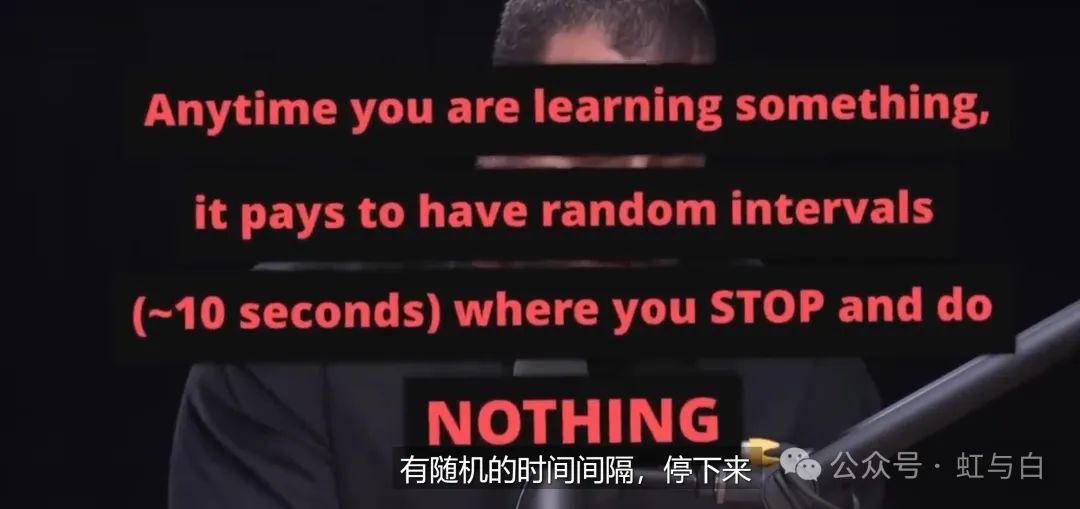
结束
参考资料
[1]
学习速度提升10倍的秘诀(根据斯坦福脑科学家): https://www.bilibili.com/video/BV1ou4y1g7zY/?spm_id_from=333.999.0.0&vd_source=1d44f7f1239b6bab3592038d5e406da0
Tag: 学习方法